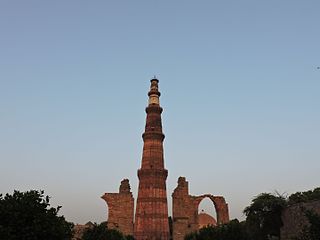Qutub Minar
Mehrauli, New Delhi, DL 110030
Phone : 011 2469 8431

This is a World heritage Site.
Qutub Minar, at 120 meters, is the tallest brick minarety in the world, and the second tallest minar in India after Fateh Burj at Mohali. Qutub Minar, along with the ancient and medieval monuments surrounding it, form the Qutub Complex. The tower is located in the Mehrauli area of Delhi, India. Made of red sandstone and marble, Qutub Minar is a 73-meter (240 feet) tall tapering tower with a diameter measuring 14.32 meters (47 feet) at the base and 2.75 meters (9 feet) at the peak. Inside the tower, a circular staircase with 379 steps leads to the top. Qutub Minar station is the closest station on the Delhi Metro.
In 1200 CE, Qutub-ud-Din Aibak, the founder of the Delhi Sultanate started construction of the Qutub Minar. In 1220, Aibak’s successor and son-in-law Iltutmish added three storeys to the tower. In 1369, lightning struck the top storey, destroying it completely and Firoz Shah Tighlaq carried out restoration work replacing the damaged storey with two new storeys every year, made of red sandstone and white marble.
Qutub Minar is surrounded by several historically significant monuments, which are historically connected with the tower and are part of the Qutb Complex. These include the Iron Pillar of Delhi , Quwwat-ul-Islam Mosque, Alai Darwaza, the Tomb of Iltutmish, Alai Minar, Ala-ud-din’s Madrasa and Tomb, and the Tomb of Imam Zamin. Other minor monuments include Major Smith’s Cupola and Sanderson’s Sundial.
The Minar is made of Dark red sandstone covered with Iron intricate carvings and verses from the Qur’an. The Minar comprises several superposed flanged and cylindrical shafts, separated by balconies carried on Muqarnas corbels. The first three storeys are made of red sandstone; the fourth and fifth and sixth storeys are of marble and sandstone. At the foot of the tower is the Quwwat ul Islam Mosque. The minar tilts just over 65 cm from the vertical, which is considered to be within safe limits, although experts have stated that monitoring is needed in case rainwater seepage further weakens the foundation.
The Iron Pillar, 7 m (23ft) high column in the Qutb complex a metallurgical curiosity, notable for the rust-resistant composition of the metals used in its construction.
The pillar has attracted the attention of archeologists and materials scientists and has been called “a testament to the skill of ancient Indian blacksmiths” because of its high resistance to corrosion. The corrosion resistance results from an even layer of crystalline iron hydrogen phosphate forming on the high phosphorus content iron, which serves to protect it from the effects of the local Delhi climate.
The pillar has Brahmic inscriptions on it and predates the Islamic minar.
Source : Wikipedia
http://www.youtube.com/watch?v=6m_7fkjOKmU
Reviews
Visiting hours : 10.00AM to 5.00 PM Open All Days.
Entry Fee : Rs 10/-for Indians and Rs.250/- for foreign Nationals.
Must Visit : Quwwat-ul-Islam Mosque to the Northeast of Minar – First Mosque Built by Delhi Sultans, Tomb of Iltutmish, Plain Square Chamber of Red Sandstone.
Don’t Miss : Hidden Pathways Used as an Escapade by the Kings, that are Believed to Lead up to the Red Fort.
Must see : Iron Pillar – never got rusted since erected, copiously carved with inscriptions on the minaret, Alai – Darwaza – an arched gate built in 1311AD.


Rate this article